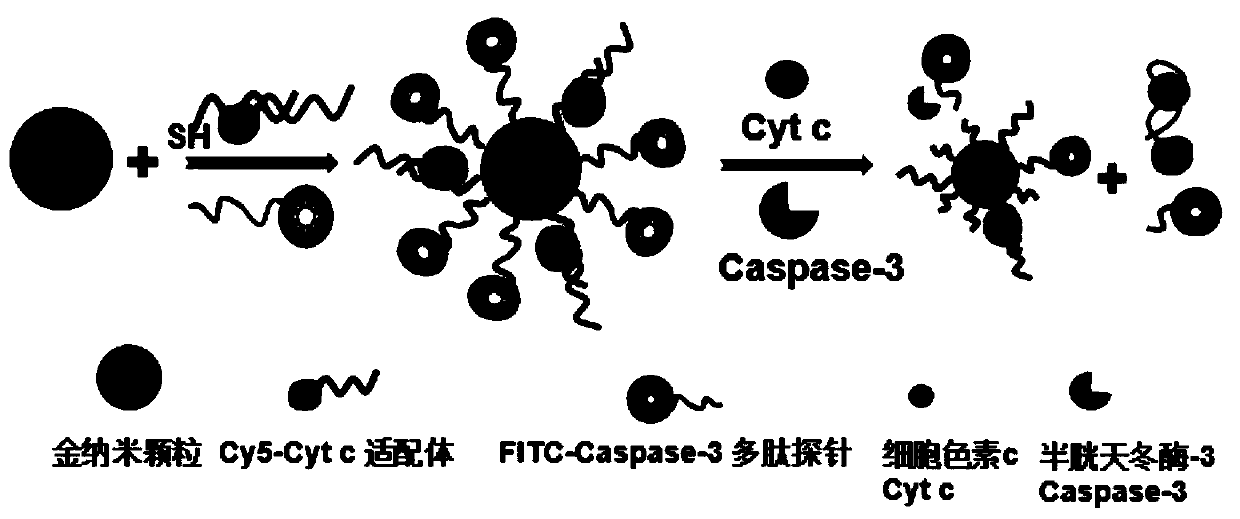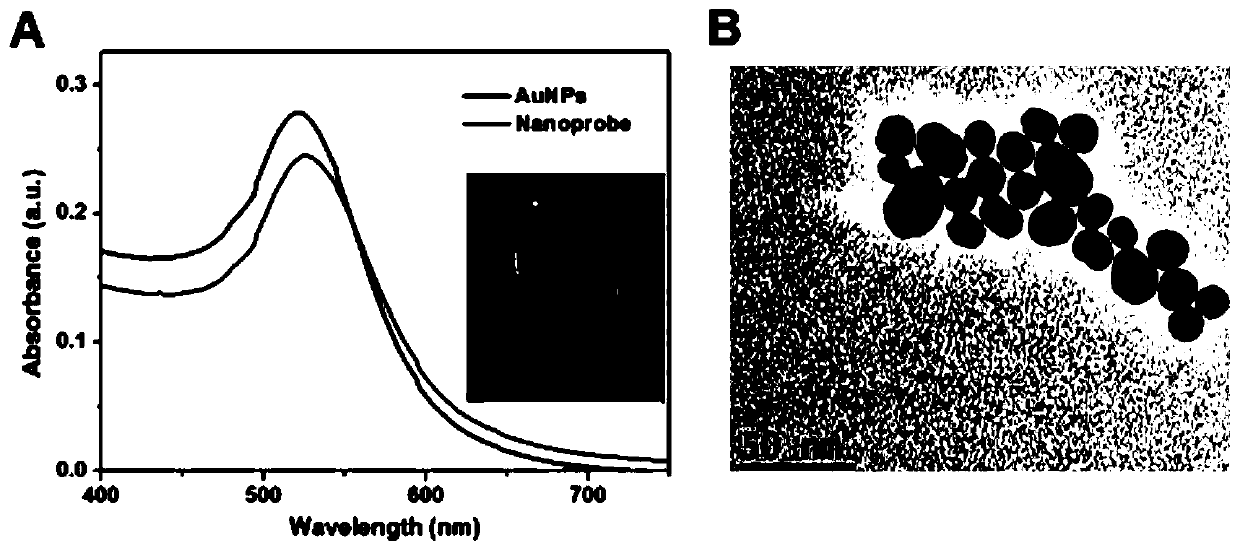A dual-color detection and imaging probe of apoptosis and its application
A technology of imaging probe and cytochrome, which is applied in the field of bioanalysis technology and nanomedicine, and achieves the effect of simple synthesis, good selectivity and high sensitivity
- Summary
- Abstract
- Description
- Claims
- Application Information
AI Technical Summary
Problems solved by technology
Method used
Image
Examples
Embodiment 1
[0031] Synthesis of gold nanoparticles: The glassware used was soaked in aqua regia for 4 hours, washed thoroughly with secondary water and dried before use. After 50 ml of 0.01% wt chloroauric acid aqueous solution was heated to boiling, 1 ml of 1% wt trisodium citrate solution was quickly added under stirring, and the reaction was continued for 20 minutes until the color changed from colorless to wine red. Cool to room temperature, and store in a 4°C refrigerator away from light until use. figure 2 A shows the absorption spectrum of gold nanoparticles.
[0032] Cytochrome c aptamer hybridized with linked DNA: the aptamer sequence of cytochrome c was 5'-CCGTGTCTGGGGCCGACCGGCGCATTGGGTACGTTGTTGC-Cy5-3'; the aptamer linked DNA sequence was 5'-SH-TTTTTTTTTTGCAACAACGTA-3'. 24 μL 100 μM cytochrome c aptamer and 20 μL 100 μM linked DNA were reacted by DNA hybridization, mixed with hybridization solution 40 μL phosphate buffer saline (PBS) (10 mM PB solution, 137 mM NaCl, 2.7 mM KC...
Embodiment 2
[0035]Fluorescence detection and caspase-3: When detecting cytochrome c, 1nM nanoprobes were reacted with different concentrations of cytochrome c in PBS at 37°C for 30 minutes to detect the fluorescence signal. The excitation wavelength is 635nm, and the detection wavelength is 665nm. When detecting caspase-3, 1nM nanoprobes were incubated with different concentrations of caspase-3 in 25mM HEPES buffer (pH 7.4, containing 100mM NaCl, 1mM EDTA, 10% sucrose, 0.1% CHAPS), and reacted at 37°C for 30 minutes Detection of fluorescent signal. The excitation wavelength is 480nm, and the detection wavelength is 520nm. The result is as image 3 As shown, the detection linear range of cytochrome c is 0-500nM, and the detection limit is 10nM; the detection linear range of caspase-3 is 0-300ng / mL, and the detection limit is 5ng / mL.
[0036] Nanoprobe detection selectivity experiment: 1nM nanoprobes were reacted with different interfering substances at 37°C for 30 minutes to detect corr...
Embodiment 3
[0039] Nanoprobes for apoptosis imaging: HeLa cells were cultured in RPMI 1640 medium containing 10% fetal bovine serum, penicillin (100 U / mL) and streptomycin (100 μg / mL) at 37°C in high humidity containing 5% in a carbon dioxide incubator. HeLa cells were cultured in a confocal imaging culture dish, and when they grew to cover 60-70% of the culture dish, washed twice with PBS, added Opti-MEM culture solution containing 1nM nanoprobes, incubated for 2 hours, washed twice with PBS, Add culture medium containing different concentrations of STS and incubate for 2 hours. After washing twice with PBS, fluorescent confocal imaging was performed. The result is as Figure 5 As shown, it is proved that the nanoprobe can dual-color image apoptosis.
[0040] Nanoprobes for apoptosis drug evaluation: HeLa cells were cultured in RPMI 1640 medium containing 10% fetal bovine serum, penicillin (100 U / mL) and streptomycin (100 μg / mL) at 37°C in high humidity containing 5 % CO2 incubator. ...
PUM
| Property | Measurement | Unit |
|---|---|---|
| size | aaaaa | aaaaa |
Abstract
Description
Claims
Application Information
 Login to View More
Login to View More - R&D Engineer
- R&D Manager
- IP Professional
- Industry Leading Data Capabilities
- Powerful AI technology
- Patent DNA Extraction
Browse by: Latest US Patents, China's latest patents, Technical Efficacy Thesaurus, Application Domain, Technology Topic, Popular Technical Reports.
© 2024 PatSnap. All rights reserved.Legal|Privacy policy|Modern Slavery Act Transparency Statement|Sitemap|About US| Contact US: help@patsnap.com










